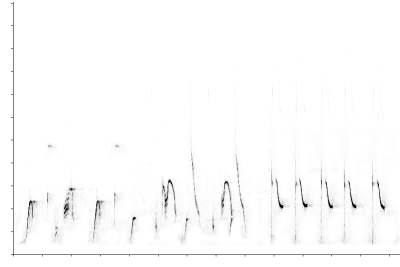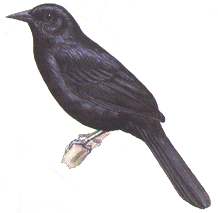
Click on spectrogram to download sound file

 |
| Melodious
Blackbird song - Zoh Laguna
Click on spectrogram to download sound file |
![]()
Song Description:
The variable song of the Melodious Blackbird consists of several sharp whistled syllables, given in many different combinations. Many songs resemble the punctuated babbling of Star Wars' R2-D2.
![]()
Song Measures:
Most syllables found in the Melodious Blackbird's repertoire are pure-tone whistles, the majority of which are downslurred notes within a frequency range of 500 to 5000 Hz. While these syllables are given in numerous combinations to produce a large variety of different vocalizations, two songs are more typical than others.
The first song, which may be recalled as broop...beep, consists of two whistles seperated by 0.5 seconds, the second almost exactly one octave above the first (e.g. the first two phrases in the example above). The first syllable is an upslurred note with a frequency range of 500 to 2200 Hz and the second syllable is a short note at 4700 Hz.
The second, more common song is a series of four or five repeats of a disyllabic element best recalled as what-cheer (e.g. the last five phrases in the example above). The first syllable is a sharp wide-band note and the second syllable is a downslurred note with a frequency range of 3200 Hz to 2000 Hz.
![]()
Singing Behaviour:
Each song is preceded by the bird visibly inflating by drawing air into its furcular sac, then orienting its bill upwards and deflating as the song progresses. The whistled notes of the Melodious Blackbird's song are very resonant, and birds were often observed countersinging over great distances across open fields and through village yards. Stiles and Skutch (1989) report that males and females may call back and forth to each other.
![]()
Habitat:
Melodious Blackbirds were always found along forest edges near the villages of Zoh Laguna and Nueva Becal. These birds occasionally forayed into the large trees in the centre of these villages and often perched with flocks of Great-tailed Grackles.
![]()
Return
to Bird Songs of the Yucatan Main Page
All
information and photographs copyright Daniel J. Mennill 1999.
No recordings or other information from this site may be used without
written permission from me.
Please email me (dmennill AT
uwindsor DOT ca) and I will happily grant permission for any
non-commercial or education purposes.